
CANADIAN PACIFIC TIME
By W.F. Tate
Chief Inspector of Time Service Eastern Lines

The cardboard sign placed next to station clocks in Canadian Pacific Railway stations.
 Introduction Many, many, years ago Canadian Pacific published a series of ten
books named the "Foundation Library". One particular book in this collection, published in 1937, is named
"Factors in Railway and Steamship Operation". It contains many short stories and articles dealing with the
company during that period. This month's article is from that book, "Canadian Pacific Time", written by
W.F. Tate and reprinted here for your enjoyment with the addition of some appropriate images.
 The 1937 Article 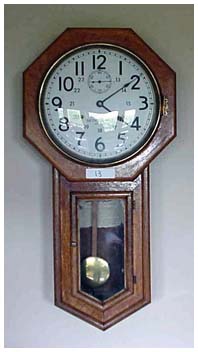 Many things combine to make for safe travelling on Canadian Pacific
Railway trains. There are safety signals, rules and regulations, standards of construction - everything that human
ingenuity and experience cold devise to prevent accidents. Many things combine to make for safe travelling on Canadian Pacific
Railway trains. There are safety signals, rules and regulations, standards of construction - everything that human
ingenuity and experience cold devise to prevent accidents.
But in the end the safety factor is only as great as the capabilities of the least dependable of thousands of workmen,
and the accuracy of the watches they carry. That is why a separate department has been set up to supervise the
Company's time system, to check on thousands of watches and clocks used in Company service, and to conduct frequent
and searching examinations into the vision, colour sense, and hearing of employees.
Before explaining how the Company keeps thousands of watches and clocks on correct time, to the fraction of a second,
it might be of interest to outline where time comes from, what it is, and why it is so important.
To a shipwrecked Crusoe on a desert island, time is nothing more than a vague, indifferent quantity, as valueless as
the gold coins he found. Darkness and dawn and the flux and flow of tides were the hands that spaced the dial for the
solitary castaway, and he needed nothing more exact.
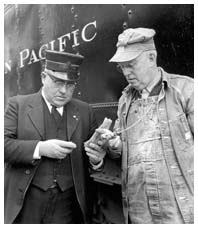 The contact of man with man, however, is what touches time to give it life. Crude methods of early days had to be
supplanted when time became a valuable international commodity. The source of absolutely correct time is the
revolution of the earth on its axis, because that is the only clock known to man that does not vary a hundredth of a
second in a thousand years. By an arrangement of telescopes and other equipment, too intricate to be explained here,
time is taken from the stars - not the sun. There are many fixed stars on which a line can be taken at the instant
that they coincide with a given meridian. The contact of man with man, however, is what touches time to give it life. Crude methods of early days had to be
supplanted when time became a valuable international commodity. The source of absolutely correct time is the
revolution of the earth on its axis, because that is the only clock known to man that does not vary a hundredth of a
second in a thousand years. By an arrangement of telescopes and other equipment, too intricate to be explained here,
time is taken from the stars - not the sun. There are many fixed stars on which a line can be taken at the instant
that they coincide with a given meridian.
Correct time became obviously important to railways in 1891 when two trains on the Lake Shore Railroad met in
head-on collision near Kipton, Ohio, killing the two engineers and several railway
mail-clerks. In the investigation which followed, it was disclosed that the watches of the engineers
differed by four minutes. As a result railways worked out a plan which provided for a rigid and continuous system of
railroad watch inspection.
Everyone who has travelled on the Canadian Pacific Railway benefits from this accident of 1891, which resulted in a
system that provides the exactitude of time with which the vast number of trains over the many lines are handled
safely and punctually.
Express, local, special, freight, excursion, construction, and other trains are forever plying to and fro along these
lines, leaving the same stations and utilizing the same switches within a few minutes of one another, yet delays and
accidents are extremely rare. This efficiency, which is primarily dependent on exact punctuality, cannot be achieved
unless all watches and clocks used by those responsible for handling trains agree and are strictly on time.
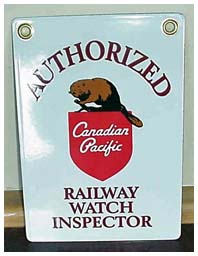 How is this accuracy maintained? Obviously there must be an elaborate organization to deal with it, for a railway
company cannot afford to take chances in such an all-important matter. The Canadian Pacific Railway
recognizes this and has perfected an extensive Time Service department, employing many men who devote all their time
and energies to checking and adjusting the Company's standard clocks and the watches carried by employees. Details of
this work are very interesting. How is this accuracy maintained? Obviously there must be an elaborate organization to deal with it, for a railway
company cannot afford to take chances in such an all-important matter. The Canadian Pacific Railway
recognizes this and has perfected an extensive Time Service department, employing many men who devote all their time
and energies to checking and adjusting the Company's standard clocks and the watches carried by employees. Details of
this work are very interesting.
In the setting of the Company's clocks, the department employs a method illustrative of the wonderful possibilities
of modern science. In certain stations, roundhouses, and yard offices there are clocks known as comparison clocks, so
called because they have been officially designated as clocks at which conductors, engineers, and others must compare
their watches and enter variations in a book supplied for that purpose before starting their run. Employees must not
set their own watches unless they have run down.
In the head office of Canadian Pacific Communications, from which telegraph lines radiate to every Canadian Pacific
telegraph station in the Dominion, there is a large comparison clock. Underneath this clock and on each side is a
receiving sounder and despatching key - the receiving sounder is electrically actuated by a clock in the McGill
Observatory, the accuracy of which is maintained by astronomical calculation and beats every two seconds; the
despatching key is used by the Wire Chief, synchronizing with the receiving key, to transmit Time Signals.
Between six minutes to twelve and four minutes to twelve, mid-day, every day of the year, seven days a
week, the McGill master clock indicates the correct time by beats on a telegraph instrument kept specially for this
purpose in the head telegraph office. The signals commence strictly on the stroke of 11:54 a.m. From that instant to
ten seconds short of 11:55, one beat is sounded at every two seconds. A pause of ten seconds follows until, on the
stroke of 11:55 a.m., two beats are sounded. This performance is once repeated ending on the stroke of 11:56. To the
Wire Chief is delegated the great responsibility of transmitting these signals to the hundreds of telegraph operators
at the comparison stations throughout the system. It is his duty to sit at a key connected with the instruments of all
these operators and repeat the signals as they are received.
In the meantime the operators have been standing by, awaiting the signal. Every telegraph instrument on the immense
transcontinental Canadian Pacific System, as the time draws near, is absolutely silent. At this dramatic moment, the
Wire Chief literally holds the system in the hollow of his hand. The beats begin. The operators at the comparison
station watch their clocks as the signals flash westwards to Vancouver and eastwards to Saint John. They note the
number of seconds' error, slow or fast (if any), registered by the clock; the signals cease and normal work is
resumed. Approximately there are 3,500 station clocks across the system and 225 electric clocks in the Windsor
Station, Montreal, alone.
 Setting Instructions Sample 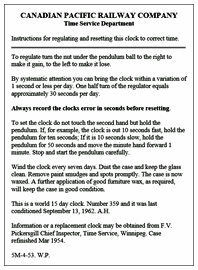
The instructions above were copied from a notice discovered inside Canadian Pacific Railway clock number 359
displayed at the Glenbow Museum in Calgary, Alberta, during "The Great CPR Exposition" of September 1983.
 Clock Installation Instructions 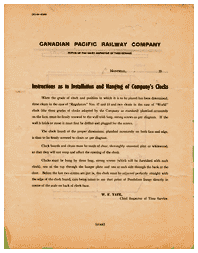 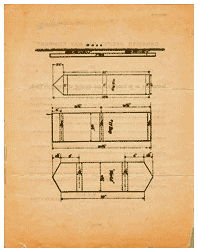
 News Articles 19 Nov 1980 - Watchmaker's Shop Adopts New Image
 Associated Web Sites Canadian Pacific Railway
Canadian Pacific Historical Association
Telegraphy
Atomic Clock - Wikipedia
Seeds of Time from the Cesium Atom
Additional CPR Web Sites

|

